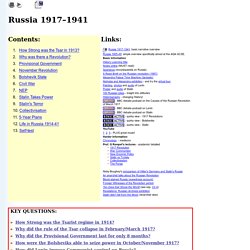

Monty Python Communist Quiz sketch. Lecture 5: The Russian Revolution (1) N.B.
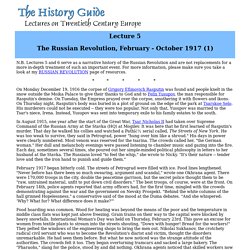
Lectures 5 and 6 serve as a narrative history of the Russian Revolution and are not replacements for a more in-depth treatment of such an important event. For more information, please make sure you take a look at my RUSSIAN REVOLUTION page of resources. On Monday December 19, 1916 the corpse of Grigory Efimovich Rasputin was found and people knelt in the snow outside the Moika Palace to give their thanks to God and to Felix Yusupov, the man responsible for Rasputin's demise. On Tuesday, the Empress prayed over the corpse, smothering it with flowers and ikons. On Thursday night, Rasputin's body was buried in a plot of ground on the edge of the park at Tsarskoe Selo. In August 1915, one year after the start of the Great War, Tsar Nicholas II had taken over Supreme Command of the Russian Army at the Stavka (HQ) at Mogilev. February 1917 began bitterly cold.
Food hoarding was common. Killing started on Saturday, February 25th. Sunday began with a deceptive calm. Situation serious. History Education. The Communist Manifesto. The Communist Manifesto summarises Marx and Engels' theories concerning the nature of society and politics, namely that in their own words "[t]he history of all hitherto existing society is the history of class struggles".
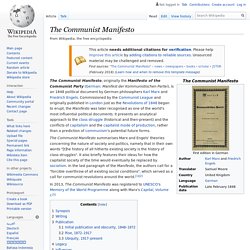
It also briefly features their ideas for how the capitalist society of the time would eventually be replaced by socialism. In the last paragraph of the Manifesto, the authors call for a "forcible overthrow of all existing social conditions", which served as a call for communist revolutions around the world.[1][2] In 2013, The Communist Manifesto was registered to UNESCO's Memory of the World Programme along with Marx's Capital, Volume I.[3] Synopsis[edit] The Communist Manifesto is divided into a preamble and four sections, the last of these a short conclusion. Engels' burial speech. The Death of Karl Marx Transcribed: by Mike Lepore, 1993.
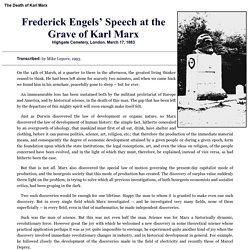
On the 14th of March, at a quarter to three in the afternoon, the greatest living thinker ceased to think. He had been left alone for scarcely two minutes, and when we came back we found him in his armchair, peacefully gone to sleep -- but for ever. An immeasurable loss has been sustained both by the militant proletariat of Europe and America, and by historical science, in the death of this man. The gap that has been left by the departure of this mighty spirit will soon enough make itself felt. But that is not all. Two such discoveries would be enough for one lifetime. Course: Reinventing Russia. History -Russian revolution. Causes of the Russian Revolution of 1917 - Mindmap in IGCSE History. Using Hexagon Learning for categorisation, linkage and prioritisation. Note: I have created an online hexagons generator at ClassTools.net.

The ability to select, prioritise, categorise and link evidence is a valuable skill that students learn in History. It is also highly transferable to other subjects. Using hexagons is a particularly simple and effective way of developing these skills. The approach involves providing students with key pieces of information on hexagons. Their job is to organise these into categories of their choice, with hexagons being placed adjacent to each other to highlight links between the factors described. These groups are then glued down onto sugar paper and then the diagram is developed with titles being written over each category, and arrows being used to connect the different categories and to chart a ‘path’ through the diagram. Taking it further. Essay quotes flashcards. The Russian Revolution. The webserver at Alpha History tells us you’re using an adblocking tool, plug-in or browser extension on your computer or network.

We understand that many people don’t like web-based advertising. Ads on websites can often be irrelevant, distracting and ‘in your face’. Without ads, however, our website would not exist – or it would not be free. Ads are how we fund the creation and delivery of our content. We love providing free textbook-quality content and resources to people like you. If you would like to use our website and its resources, please disable your adblocker or whitelist our website. The Russian Revolution (2006) The 1905 Russian Revolution was a wave of mass political and social unrest that spread through vast areas of the Russian Empire.
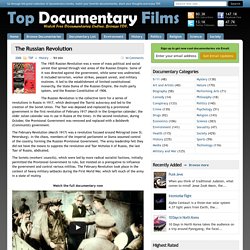
Some of it was directed against the government, while some was undirected. It included terrorism, worker strikes, peasant unrest, and military mutinies. World History Teachers Blog: Russian Revolution Documentary Clips. AS Unit 1.
RUSSIAN REVOLUTION - FLOW CHARTS. Russian revolution. Russia 1917-1941. In this module you will learn: • FIVE strengths and SEVEN weaknesses of the Tsar’s Government in 1913 • FIVE causes of the March 1917 Revolution [Why Was There A Disaster?]
